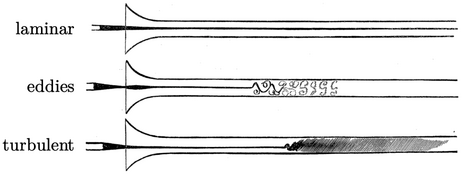6.1 Reynolds experiment
Reynolds distinguished the laminar and
turbulent flow regimes in his influential experiments in the early
1880s.1 At
that time, Poisueille’s law predicted correctly that the resistance
to flow in a pipe  for laminar flow at speed
for laminar flow at speed  , which typically
occurs at small
, which typically
occurs at small  and/or diameter
and/or diameter  . Reynolds wanted to
understand why, at higher
. Reynolds wanted to
understand why, at higher  and/or
and/or  , resistance
, resistance
 (approximately).
(approximately).

His experiment used a large, glass-walled tank
filled with water. A glass tube with a flared intake passed through
the tank and out through one wall. Water from the tank flowed along
the tube at speed  , controlled by an outlet valve. A jet of liquid
dye was injected at the inlet to the tube to visualise the flow.
, controlled by an outlet valve. A jet of liquid
dye was injected at the inlet to the tube to visualise the flow.
The observed behaviour is shown in Reynolds’s
original drawings on the following page. At sufficiently low speed,
the streak of dye followed a straight line along the tube,
indicating laminar flow. The speed was increased in small steps
until at some distance from the tube intake (typically,
30 )
the dye would mix with the water, rapidly filling the tube. This
marked the transition to turbulent
flow.
)
the dye would mix with the water, rapidly filling the tube. This
marked the transition to turbulent
flow.

Reynolds made the following important observations.
- Distinct eddies were visible during turbulent flow, see above.
- The transition speed was very sensitive to disturbances in the water entering the tube, even due to the temperature variations in the water.
- Before full transition was reached, intermittent “spots” of turbulence appeared and disappeared.
Reynolds number
Reynolds argued that the transition is
controlled by the Reynolds number,  from
Eq. (2.68
), using the
characteristic length
from
Eq. (2.68
), using the
characteristic length  in a pipe. His deduction was based on the idea
of scale similarity, introduced in Sec. 2.21
.
in a pipe. His deduction was based on the idea
of scale similarity, introduced in Sec. 2.21
.
He observed that with minimal disturbance in the
tank, the transition to turbulent flow occurred at  13000. When
disturbances were evidently present, the transition occurred at
13000. When
disturbances were evidently present, the transition occurred at
 2000. An updated view for pipe flow is that for
2000. An updated view for pipe flow is that for
 2000, all disturbances will decay preventing the onset
of turbulent flow. For
2000, all disturbances will decay preventing the onset
of turbulent flow. For  2000, transition depends on initial
disturbances and the roughness of the pipe wall.
2000, transition depends on initial
disturbances and the roughness of the pipe wall.

